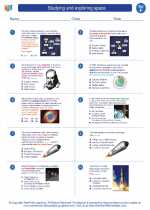Nebulae
A nebula is a vast, diffuse cloud of gas and dust in space, where new stars are often born. Nebulae are among the most beautiful objects in the universe and have fascinated astronomers for centuries. There are several different types of nebulae, each with its own unique characteristics.
Types of Nebulae
- HII regions: These are large, low-density clouds of partially ionized gas, primarily made up of hydrogen. They are often associated with regions of star formation and are the birthplaces of new stars.
- Reflection nebulae: These nebulae are made up of dust and gas that simply reflect the light of nearby stars. They often appear blue because the dust particles preferentially scatter blue light.
- Planetary nebulae: These are the remnants of dying stars, where the outer layers are ejected into space, forming a shell of gas and dust around the stellar core.
- Supernova remnants: These are the remains of massive stars that have exploded in violent supernova events, leaving behind expanding clouds of gas and dust.
- Dark nebulae: These are dense clouds of gas and dust that obscure the light from objects behind them, creating dark patches in the sky.
Formation of Nebulae
Nebulae are formed through a variety of processes, including the gravitational collapse of gas clouds, the expulsion of outer layers by dying stars, and the shock waves generated by supernova explosions. These processes can lead to the formation of new stars and planetary systems within the nebulae.
Observing Nebulae
Nebulae can be observed using telescopes that are sensitive to the light emitted or reflected by the gas and dust within the nebulae. Astronomers study the properties of nebulae to understand the processes of star formation, stellar evolution, and the chemical composition of the universe.
Study Guide
- Describe the different types of nebulae and their characteristics.
- Explain the processes involved in the formation of nebulae.
- Discuss the significance of studying nebulae in astronomy and astrophysics.
- Identify and describe specific examples of famous nebulae, such as the Orion Nebula or the Crab Nebula.
Understanding the nature and properties of nebulae is essential for comprehending the life cycle of stars and the formation of galaxies. Studying nebulae provides valuable insights into the workings of the universe and the processes that shape the cosmos.
.◂Science Worksheets and Study Guides Sixth Grade. Studying and exploring space

 Worksheet/Answer key
Worksheet/Answer key
 Worksheet/Answer key
Worksheet/Answer key
 Worksheet/Answer key
Worksheet/Answer key
 Vocabulary/Answer key
Vocabulary/Answer key
 Vocabulary/Answer key
Vocabulary/Answer key
 Vocabulary/Answer key
Vocabulary/Answer key
 Vocabulary/Answer key
Vocabulary/Answer key
